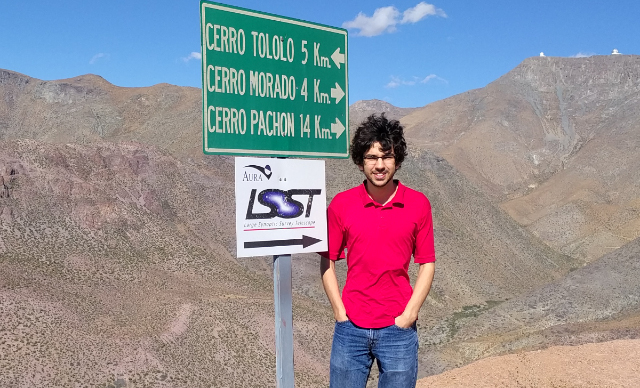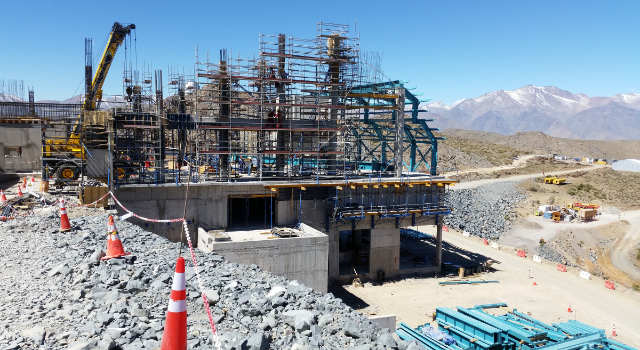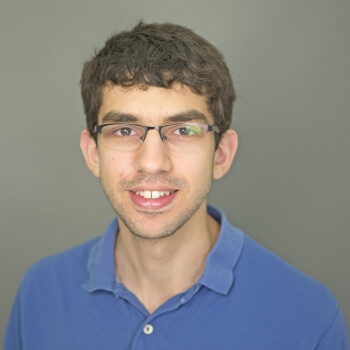News
Daniel Rothchild, A.B. ’17, a physics concentrator who is pursing a secondary in computer science at the Harvard John A. Paulson School of Engineering and Applied Sciences is developing a schedling algorithm for the Large Synoptic Survey Telescope. (Photo by Adam Zewe/SEAS Communications.)
When it begins operating in 2022, the $500 million Large Synoptic Survey Telescope (LSST) will capture some of the sharpest night sky images ever produced, giving scientists an unprecedented view of near-Earth asteroids, supernovae, and the Milky Way galaxy.
But the telescope, under construction atop a peak is Chile’s northern Andes, also presents an unprecedented challenge for astrophysicists—it will require a complicated scheduling algorithm to determine where to point the telescope as it traces the sky. To Harvard student Daniel Rothchild, that sounded like a puzzle he could solve.
“This is not a well-studied problem in astrophysics because there has never been a telescope that behaved like this,” said Rothchild, A.B. ’17, a physics concentrator who is pursing a secondary in computer science at the John A. Paulson School of Engineering and Applied Sciences. “But scheduling is a well-studied problem in computer science. It is very important that the scheduler be effective, or the telescope is not going to be looking at the places that will yield the best data.”
Working with Christopher Stubbs, Samuel C. Moncher Professor of Physics and Astronomy, who is a contributor to the LSST project, Rothchild launched an independent research project to develop a scheduling algorithm that would be effective in this unique situation.

Rothchild stands near the LSST construction site, high in the Andes mountains of Chile. (Photo provided by Daniel Rothchild.)
The LSST, which will image the entire night sky every three days, will stop at each point for 30 seconds before moving onto a new field. Longer calculation time leads to a much more complicated algorithm and that could easily bog down the telescope’s progress. The algorithm must also overcome the challenge of determining the “best” place for the telescope to look, when there are literally 10 billion possibilities.
“How do you decide if Milky Way astronomy is more important than asteroid science on this particular 30-second exposure?” Rothchild asked. “It’s very difficult for scientists to say, here’s an exact quantification of how important these different areas are.”
Rather than using machine-learning or mathematical merit functions to determine the ideal next field, Rothchild is writing code that will give the telescope a baseline optimal path to follow, along with instructions for how to respond when faced with adverse weather and unexpected downtime.
Programming a set path for the entire 10-year span of the project allows scientists to explicitly optimize global properties of the telescope’s data, instead of hoping the merit functions or machine-learning algorithms will perform those optimizations themselves, he said. It also eliminates the headaches of trying to determine why the computer pointed the telescope at a certain location, or troubleshooting a machine-learning algorithm that seems to be aiming the telescope far off the best course.
“There are certain astronomical elements that are fixed, even 10 years out. We know the moon will be moving a certain way and the stars will appear in specific patterns and locations, and we also know the meridian is generally the best place to point the telescope because there is the least amount of air overhead,” he said. “By programming these considerations into the scheduler explicitly, I hope to create an algorithm that will produce better schedules than those produced with existing methods.”
His code lays out a path for the telescope to follow using a combination of astronomical data and meteorological predictions. Rothchild’s method involves much faster calculations than other scheduler algorithms because there are no machine-learning elements.
Several other researchers are working on schedulers, and all have taken a slightly different approach. Once the telescope hardware is complete, the LSST leadership team will test each scheduler and select the one to use.
Though he still has six years to wait before the LSST has its eye on the sky, Rothchild is excited for the opportunity to contribute to such a significant astrophysics project.
“The LSST will produce about 15 terabytes of data each night for 10 years. By comparison, the Hubble telescope produces 10 terabytes of data in one year,” he said. “This project is going to enable scientists to take precision measurements of the universe in an unprecedented way. It is very cool to be a part of that.”

Currently under construction in Chile, the LSST will incorporate the world's largest digital camera. (Photo credit: LSST.)
Topics: Computer Science
Cutting-edge science delivered direct to your inbox.
Join the Harvard SEAS mailing list.
Press Contact
Adam Zewe | 617-496-5878 | azewe@seas.harvard.edu



